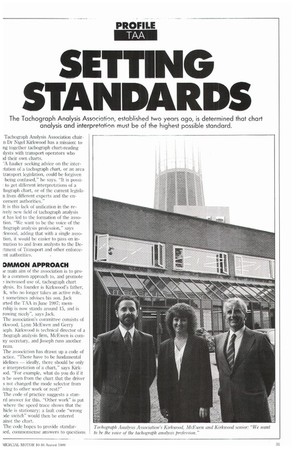SETTING STANDARDS
Page 33

If you've noticed an error in this article please click here to report it so we can fix it.
Tachograph Analysis Association chair,n Dr Nigel Kirkwood has a mission: to ng together tachograph chart-reading ilysts with transport operators who id their own charts.
'A haulier seeking advice on the interAation of a tachograph chart, or an area transport legislation, could be forgiven being confused," he says. "It is possito get different interpretations of a hograph chart, or of the current legislan from different experts and the en'cement authorities."
It is this lack of unification in the reively new field of tachograph analysis it has led to the formation of the assotion. "We want to be the voice of the :hograph analysis profession," says rkwood, adding that with a single assotion, it would be easier to pass on inillation to and from analysts to the Dertment of Transport and other enforcenit authorities.
ie main aim of the association is to prole a common approach to, and promote increased use of, tachograph chart alysis. Its founder is Kirkwood's father, who no longer takes an active role, t sometimes advises his son. Jack irted the TAA in June 1987; memrship is now stands around 15, and is rowing nicely", says Jack.
The association's committee consists of rkwood, Lynn McEwen and Gerry ieph. Kirkwood is technical director of a Alograph analysis firm, McHwen is cornny secretary, and Joseph runs another reau.
The association has drawn up a code of actice. "There have to be fundamental idelines — ideally, there should be only e interpretation of a chart," says Kirkiod. "For example, what do you do if it n be seen from the chart that the driver s not changed the mode selector from iying to other work or rest?"
The code of practice suggests a stanrd answer for this. "Other work" is put where the speed trace shows that the hide is stationary: a fault code "wrong 1de switch" would then be entered ainst the chart.


































































































































